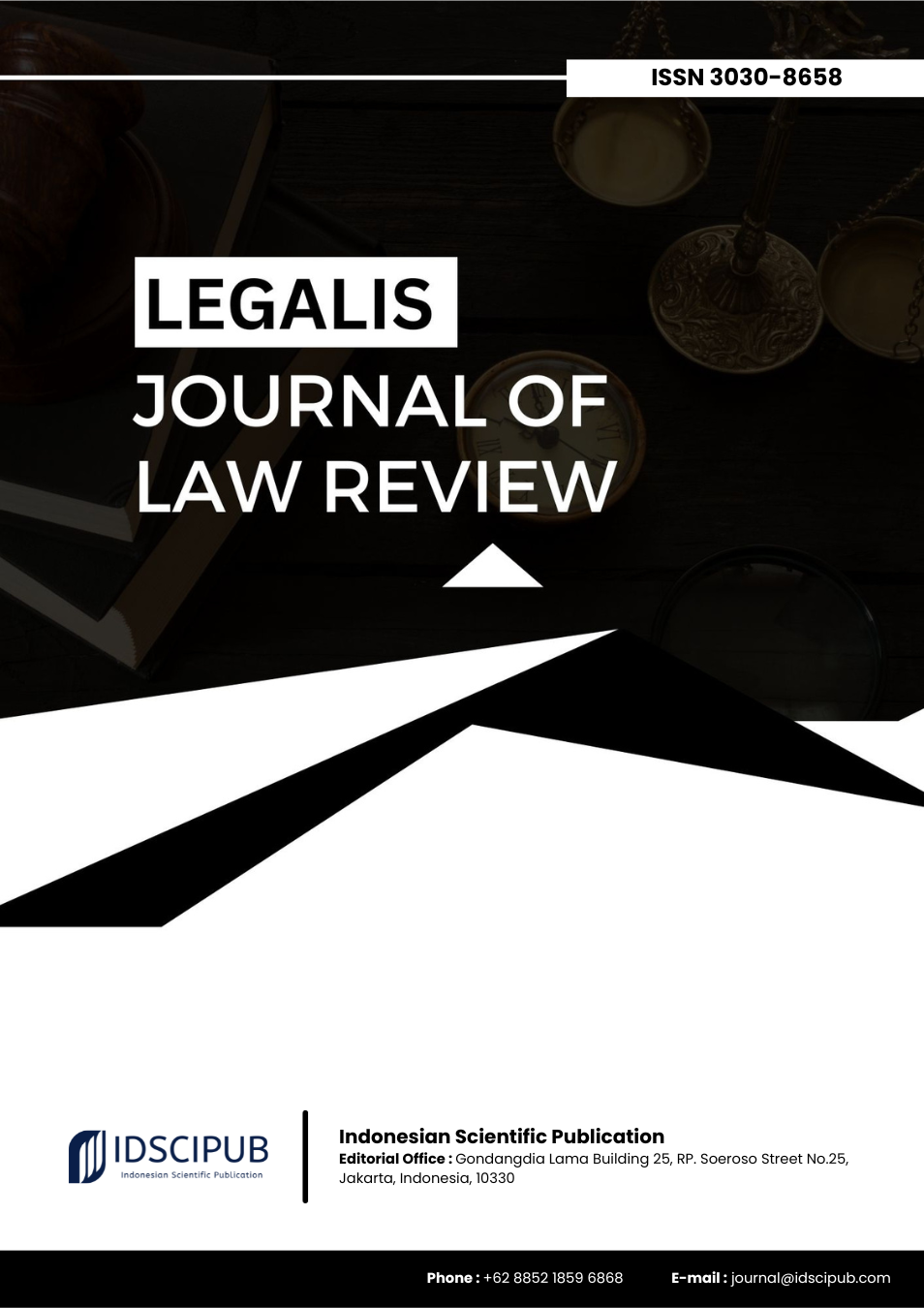Governing AI: A Narrative Review of Algorithmic Accountability and Legal Frameworks
DOI:
https://doi.org/10.61978/legalis.v3i2.810Keywords:
Algorithmic Accountability, AI Regulation, Legal Frameworks, Ethical AI, Transparency, Explainability, Human RightsAbstract
The rapid integration of artificial intelligence (AI) into legal systems has sparked critical debates regarding algorithmic accountability and the adequacy of current regulatory frameworks. This narrative review aims to examine the intersection of AI and law, focusing on global responses to the ethical, legal, and social challenges posed by AI-driven decision-making systems. Utilizing a comprehensive literature search through databases such as Scopus, Google Scholar, and PubMed, key studies were identified based on relevance to AI ethics, algorithmic bias, legal governance, and data privacy. Inclusion criteria emphasized empirical and conceptual works related to legal and ethical dimensions of AI regulation. The findings reveal significant disparities in the regulatory readiness of nations, with developed countries often employing a combination of hard and soft law to enhance accountability, while developing regions struggle with infrastructural and institutional constraints. Case studies from the United States, European Union, and Southeast Asia illustrate contrasting approaches and outcomes. Central themes emerging from the literature include the need for transparency, explainability, and human rights-based governance. The review highlights systemic barriers, such as inflexible legal systems and limited stakeholder engagement, that hinder effective regulation. It calls for adaptive legal frameworks, greater interdisciplinary collaboration, and proactive policymaking. These findings underscore the imperative to build ethical and accountable AI governance models that safeguard individual rights without stifling innovation.
References
Ahmad, N. (2024). Climate change-induced disaster displacement and law in India: Positioning the operationalization of artificial intelligence for protecting human rights, 121–139. https://doi.org/10.1007/978-981-97-3234-0_8 DOI: https://doi.org/10.1007/978-981-97-3234-0_8
(2020). Algorithms and law. https://doi.org/10.1017/9781108347846 DOI: https://doi.org/10.1017/9781108347846
Belle, M., & Cytowski, T. (2021). Artificial intelligence and intellectual property. https://doi.org/10.1093/oso/9780198870944.001.0001 DOI: https://doi.org/10.1093/oso/9780198870944.001.0001
Bloznelis, M. (2015). Degree-degree distribution in a power law random intersection graph with clustering, 42–53. https://doi.org/10.1007/978-3-319-26784-5_4 DOI: https://doi.org/10.1007/978-3-319-26784-5_4
Chhillar, D., & Aguilera, R. (2022). An eye for artificial intelligence: Insights into the governance of artificial intelligence and vision for future research. Business & Society, 61(5), 1197–1241. https://doi.org/10.1177/00076503221080959 DOI: https://doi.org/10.1177/00076503221080959
Cunningham, J. (2025). Painting in gray: The legal and ethical ambiguities of AI-generated art. Journal of Information Communication and Ethics in Society, 23(3), 384–391. https://doi.org/10.1108/jices-01-2025-0011 DOI: https://doi.org/10.1108/JICES-01-2025-0011
Custers, B., Lahmann, H., & Scott, B. (2025). From liability gaps to liability overlaps: Shared responsibilities and fiduciary duties in AI and other complex technologies. AI & Society, 40(5), 4035–4050. https://doi.org/10.1007/s00146-024-02137-1 DOI: https://doi.org/10.1007/s00146-024-02137-1
Engstrom, D., & Haim, A. (2023). Regulating government AI and the challenge of sociotechnical design. Annual Review of Law and Social Science, 19(1), 277–298. https://doi.org/10.1146/annurev-lawsocsci-120522-091626 DOI: https://doi.org/10.1146/annurev-lawsocsci-120522-091626
Fernando, Z., Kristanto, K., Anditya, A., Hartati, S., & Baskara, A. (2023). Robot lawyer in Indonesian criminal justice system: Problems and challenges for future law enforcement. Lex Scientia Law Review, 7(2), 489–528. https://doi.org/10.15294/lesrev.v7i2.69423 DOI: https://doi.org/10.15294/lesrev.v7i2.69423
Garcia, P., Darroch, F., West, L., & Brooks-Cleator, L. (2020). Ethical applications of big data-driven AI on social systems: Literature analysis and example deployment use case. Information, 11(5), 235. https://doi.org/10.3390/info11050235 DOI: https://doi.org/10.3390/info11050235
Ghose, A., Ali, S., & Mishra, A. (2024). Artistic expressions, generative AI, and legal tapestry, 198–214. https://doi.org/10.4018/979-8-3693-1950-5.ch011 DOI: https://doi.org/10.4018/979-8-3693-1950-5.ch011
Hacker, P., Cordes, J., & Rochon, J. (2023). Regulating gatekeeper artificial intelligence and data: Transparency, access and fairness under the Digital Markets Act, the General Data Protection Regulation and beyond. European Journal of Risk Regulation, 15(1), 49–86. https://doi.org/10.1017/err.2023.81 DOI: https://doi.org/10.1017/err.2023.81
Hickman, E., & Petrin, M. (2021). Trustworthy AI and corporate governance: The EU’s ethics guidelines for trustworthy artificial intelligence from a company law perspective. European Business Organization Law Review, 22(4), 593–625. https://doi.org/10.1007/s40804-021-00224-0 DOI: https://doi.org/10.1007/s40804-021-00224-0
Khan, A. (2024). The intersection of artificial intelligence and international trade laws: Challenges and opportunities. IIUM Law Journal, 32(1), 103–152. https://doi.org/10.31436/iiumlj.v32i1.912 DOI: https://doi.org/10.31436/iiumlj.v32i1.912
Kontiainen, L., Koulu, R., & Sankari, S. (2022). Research agenda for algorithmic fairness studies: Access to justice lessons for interdisciplinary research. Frontiers in Artificial Intelligence, 5. https://doi.org/10.3389/frai.2022.882134 DOI: https://doi.org/10.3389/frai.2022.882134
Lami, B., Hussein, S., Rajamanickam, R., & Emmanuel, G. (2024). The role of artificial intelligence (AI) in shaping data privacy. International Journal of Law and Management. https://doi.org/10.1108/ijlma-07-2024-0242 DOI: https://doi.org/10.1108/IJLMA-07-2024-0242
Louati, H., Louati, A., Almekhlafi, A., ElSaka, M., Alharbi, M., Kariri, E., … & Altherwy, Y. (2024). Adopting artificial intelligence to strengthen legal safeguards in blockchain smart contracts: A strategy to mitigate fraud and enhance digital transaction security. Journal of Theoretical and Applied Electronic Commerce Research, 19(3), 2139–2156. https://doi.org/10.3390/jtaer19030104 DOI: https://doi.org/10.3390/jtaer19030104
Muhl, E. (2024). The challenge of wearable neurodevices for workplace monitoring: An EU legal perspective. Frontiers in Human Dynamics, 6. https://doi.org/10.3389/fhumd.2024.1473893 DOI: https://doi.org/10.3389/fhumd.2024.1473893
Nohara, I., & Colombo, B. (2019). Tecnologias cívicas na interface entre direito e inteligência artificial: Operação serenata de amor para gostosuras ou travessuras?. A&C - Revista de Direito Administrativoe & Constitucional, 19(76), 83. https://doi.org/10.21056/aec.v19i76.1100 DOI: https://doi.org/10.21056/aec.v19i76.1100
Phillips, A., & Mian, S. (2019). Governance and assessment of future spaces: A discussion of some issues raised by the possibilities of human–machine mergers. Development, 62(1–4), 66–80. https://doi.org/10.1057/s41301-019-00208-1 DOI: https://doi.org/10.1057/s41301-019-00208-1
Quinn, K., & Grossman, D. (2020). At the crossroads of religion and palliative care in patients with dementia. Israel Journal of Health Policy Research, 9(1). https://doi.org/10.1186/s13584-020-00401-5 DOI: https://doi.org/10.1186/s13584-020-00401-5
Sander, B. (2025). Confronting risks at the intersection of climate change and artificial intelligence: The promise and perils of rights-based approaches. Netherlands Quarterly of Human Rights. https://doi.org/10.1177/09240519251336962 DOI: https://doi.org/10.1177/09240519251336962
Singh, H. (2024). Legal aspects of digital ethics in the age of artificial intelligence, 144–167. https://doi.org/10.4018/979-8-3693-3334-1.ch005 DOI: https://doi.org/10.4018/979-8-3693-3334-1.ch005
Tomaževič, N., Murko, E., & Aristovnik, A. (2024). Organisational enablers of artificial intelligence adoption in public institutions: A systematic literature review. Central European Public Administration Review, 22(1), 109–138. https://doi.org/10.17573/cepar.2024.1.05 DOI: https://doi.org/10.17573/cepar.2024.1.05
Verma, K. (2024). Digital deception: The impact of deepfakes on privacy rights. Lex Scientia Law Review, 8(2), 859–896. https://doi.org/10.15294/lslr.v8i2.13749 DOI: https://doi.org/10.15294/lslr.v8i2.13749
Zhang, N., & Zhang, Z. (2023). The application of cognitive neuroscience to judicial models: Recent progress and trends. Frontiers in Neuroscience, 17. https://doi.org/10.3389/fnins.2023.1257004 DOI: https://doi.org/10.3389/fnins.2023.1257004







